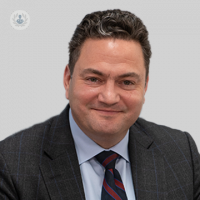What to do if an ankle sprain isn’t healing
Escrito por:An ankle sprain is a very common injury and the vast majority get better over a period of a few weeks. The difficulty is that ankle sprains can represent a spectrum of injuries. This can be from very minor strains to the lateral ligaments, to much more significant ligament injuries that involve ligament ruptures. These can be associated with significant damage to the inside of the joint.
Worried that your ankle sprain isn't healing at all? Expert consultant orthopaedic surgeon Mr Dean Michael explains what to do next and whether ankle ligament surgery is necessary.

What should I do if my ankle sprain isn’t healing?
Although the length of time that it takes patients to recover varies, the majority of patients should expect a significant improvement or resolution of symptoms over a period of about six weeks.
My advice is that if patients are struggling to return to normal over a six-week period, particularly if they've had physiotherapy, then they should probably be investigated to ensure that they don't have a more significant ligament injury or a cartilage injury to the inside of the joint.
When would you need ankle ligament surgery?
Ankle ligament injuries or ankle sprains are some the most common lower limb injuries that we see, and the vast majority of patients do very well with conservative treatment.
Conservative treatment initially is in the form of rest, elevation and icing.
Physiotherapy is very effective at helping to return to normal function. Physiotherapy concentrates on what we call proprioception exercises; which are balance exercises to help re-gain ankle stability. A very small proportion of patients have ongoing symptoms of either pain or instability. That instability can show itself either as repeated ankle sprains, or giving way, or can be much more subtle in the form of difficulty walking on rough surfaces or uneven ground. In the case of ladies, it's the inability to wear high heels.
Most patients get better with physiotherapy, but there's a small proportion that still struggles. If they have ongoing instability symptoms, they are very successfully treated with an operation to reconstruct their ligaments.
For an expert medical opinion, do not hesitate to book an appointment with Mr Michael if you're worried about your ankle sprain.



